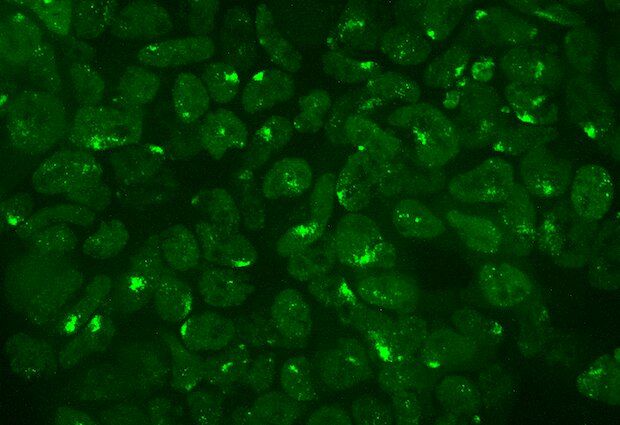Page 7865

No, these are not pictures of caramel corn—they’re the new close-ups of the sun, taken by the largest solar telescope ever built, and they’re what the Internet has been abuzz about for a week. The Daniel K. Inouye Solar Telescope (DKIST) is able to capture imagery three times more detailed than anything we’ve seen before. What we’re looking at here in this video are huge bubbling cells as big as Texas, transferring heat from the sun’s interior to its surface, but the telescope can also resolve tiny features as small as Manhattan Island within the cells!
The DKIST is about 13 feet wide and has a better-than-bird’s-eye-view at 10,000 feet above sea-level on the summit of Haleakala, a massive shield volcano on Hawaii’s island Maui. The area covered in this image is about 22,600 miles by 22,600 miles, but the cell-like structures shown are about the size of Texas.
This is only the first time it’s been used so far, and scientists are hoping that in the future it will be helpful in predicting solar weather. Scientists still have a lot of questions about the dynamical processes in the sun and space weather is a focus that can have significant impact on the everyday individual. Space weather has a huge influence on our air travel and satellite communication, sometimes causing power outages and system failures, and our technology has only given us about 48 minutes’ notice until now. The DKIST will help us predict solar flares 48 hours in advance and understand space weather like we never have before.
Feb 7, 2020
Congress Proposes Nationwide Network of Electric Car Chargers
Posted by Quinn Sena in categories: government, sustainability, transportation
Representatives Alexandria Ocasio-Cortez and Andy Levin have introduced a new bill that would build a national infrastructure for electric vehicles.
The EV Freedom Act would allocate the resources for the U.S. to build a nationwide network of electric vehicle chargers within five years, Reuters reports. That would alleviate a major hurdle to widespread electric car adoption, making it far easier for the population to transition away from gas power.
Feb 7, 2020
Embrace human genome editing
Posted by Paul Battista in categories: bioengineering, biotech/medical, genetics, government, neuroscience, time travel

Imagine then, the emancipatory potential of genome editing for these millions.
Realizing this potential, however, will require that genome editing meet with societal approval. The typical response right now when you talk to someone about genetic engineering or reproductive technology is a reference to ‘designer babies,’ eugenics, Nazism, and other evils. These arguments have a very powerful emotional hold over many people, but in my opinion, they simply don’t stand up to scrutiny.
Feb 7, 2020
Dr. Dean Ornish
Posted by Paul Battista in categories: biotech/medical, health, sustainability

https://www.youtube.com/user/DrDeanOrnish
Reverse disease following Dean Ornish’s program.
The Ornish channel is designed to help people improve their health through learning about sustainable lifestyle changes, while also connecting with others on…
Feb 7, 2020
Watch a Mother Reunite With Her Deceased Child in VR
Posted by Brent Ellman in category: virtual reality
Feb 7, 2020
Scientists explore how females shut off their second X chromosome
Posted by Quinn Sena in categories: biological, genetics, sex
Researchers at the European Molecular Biology Laboratory (EMBL) in Heidelberg and Institut Curie in Paris have shown that the protein SPEN plays a crucial role in the process of X-chromosome inactivation, whereby female mammalian embryos silence gene expression on one of their two X chromosomes.
In their landmark research published in Nature on 5 February, the scientists reveal how SPEN targets and silences active genes on the X chromosome, providing important new insights into the molecular basis of X-inactivation.
In mammals, males and females differ genetically in their sex chromosomes—XX in females and XY in males. This leads to a potential imbalance, as more than a thousand genes on the X chromosome would be expressed in a double dose in females compared to males. To avoid this imbalance, which has been shown to lead to early embryonic lethality, female embryos shut down the expression of genes on one of their two X chromosomes.
Feb 7, 2020
There’s a Cancer Treatment That Gives People ‘Night Vision’, And We Finally Know Why
Posted by Quinn Sena in category: biotech/medical
Amongst all the different types of cancer treatment, photodynamic therapy — where light in is used to destroy malignant cells — might have one of the strangest side effects: patients are often better able to see in the dark.
Now researchers have figured out why this happens: rhodopsin, a light-sensitive protein in the retinas in our eyes, interacts with a photosensitive compound called chlorin e6, a crucial component of this type of cancer treatment.
The work builds on what scientists already know about the organic compound retinal, which is found in the eye and usually isn’t sensitive to infrared light.
Feb 7, 2020
This Exolung promises ‘unlimited’ air supply underwater
Posted by Quinn Sena in category: futurism

The Exolung is aiming for the sweet spot between scuba and snorkeling by using the power of kicking legs to pull a steady supply of air down from the surface.
CNET playlists: https://www.youtube.com/user/CNETTV/playlists
Download the new CNET app: https://cnet.app.link/GWuXq8ExzG
Like us on Facebook: https://www.facebook.com/cnet
Follow us on Twitter: https://www.twitter.com/cnet
Follow us on Instagram: http://bit.ly/2icCYYm
#Exolung #DiveTech
Feb 7, 2020
Boeing’s Starliner test flight had a 2nd critical software issue, NASA panel finds (report)
Posted by Brent Ellman in category: space
Boeing is considering another test flight for its CST-100 Starliner commercial crew spacecraft amid concerns from a NASA safety panel about its first flight.
Boeing’s Starliner spacecraft launched on Dec. 20, but was unable to dock with the International Space Station as planned because it ended up in the wrong orbit. But of growing concern now are two software problems that were uncovered after the flight was complete.














